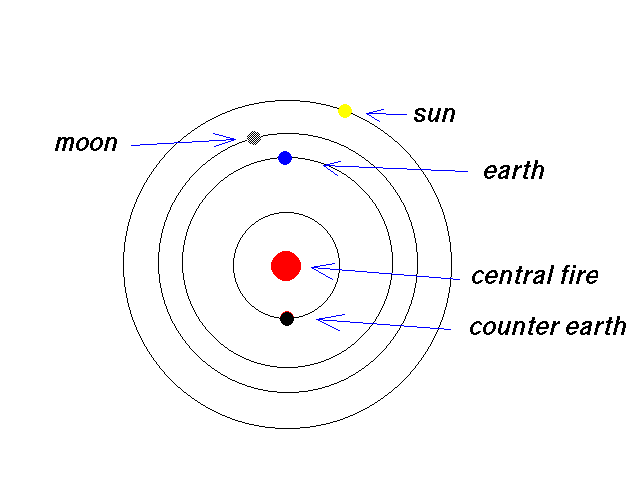BACK NEXT
Pythagoras 3
Home
The school of Pythagoras
- Pythagoras of Samos (c 500-428 BC) is famous as a mathematician. His
followers proposed astronomical theories that they often attributed to
Pythagoras.
- Philoaus, the Pythagorean (c 470-400 BC) proposed a rather detailed
theory.
Here is a picture representing part of this theory.

- The planet orbits, not shown, go outside of this.
- The stars are outside of that.
- The earth is a sphere.
- Everything moves in a circular orbit. (The orbits are not drawn to scale.)
- The earth is not at the center.
- The ``central fire'' is at the center.
- The earth orbits the central fire once per (sidereal) day. That causes
everything outside the earth's orbit, such as the sun, to move across the sky
once per day.
- The earth turns on its axis so as to keep the side that Greece is on
facing away from the central fire (otherwise it would be too warm!).
- Note that the sun, moon, planets and stars rise and set because the earth
turns on its axis once per day.
- There is also a ``counter earth'' that orbits the central fire once per
day, keeping on the other side of the central fire (not as drawn in your
book.) Why? Otherwise there would have been 9 objects in the system and the
Pythagorean's liked to have 10 things.
- The sun moves around its orbit once per year, so that it has the right
motion relative to the stars on the celestial sphere.
This model was not compared in detail to observations, but it did introduce
important ideas of spheres and circular orbits and, evidently, it does get some
things qualatively right.
Reference: Theodor S. Jacobsen, Planetary Systems from the Ancient
Greeks to Kepler (University of Washington Press, 1999).
BACK NEXT
Pythagoras 3
Home

